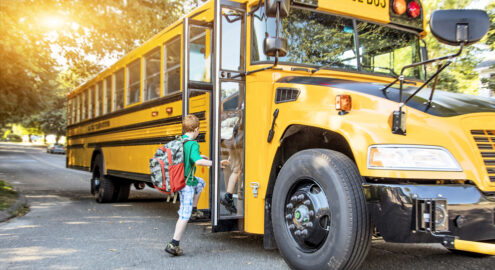Risk
Using Big Data To Prevent And Mitigate School Shootings - Expert Interview from Total Security Solutions

This article was published by Total Security Solutions on January 17, 2018 [LINK]
In the United States, school shootings resulting in injury or death are now a weekly occurrence. In 37% of these attacks someone dies. Just in the last five years, we’ve seen a total of 160 school shootings resulting in 59 deaths and 124 non-fatal injuries. By contrast, fires are 76 times more common than shootings in American schools, but only about 2% of all school fires cause any injuries, let alone a fatality. (Fewer than 0.1% of school fires result in a fatality.)
How can we reduce the severity of school shootings as successfully as we’ve reduced the severity of school fires?
Shootings, Fires, and Extreme Weather: Gauging Probability and Severity in Our Schools
In terms of risk assessment, a school shooting is a “low probability, high severity” event: It’s not likely to happen, but if it does, it will be awful. A building fire, on the other hand, is a “high probability, low severity” event: Unconfined building fires happen often, but rarely spread beyond the point of ignition or cause meaningful building damage, let alone lead to injury.
There is often a temptation to dismiss low probability, high severity events as “unforeseeable.”
After all, they are by definition uncommon, and thus give us few opportunities to find the best preparations and responses.
But schools have mitigated other “unforeseeable” threats in the past—and with remarkable success. As Daniel Young, Founder and CEO at Circadian Risk, points out: “We often effectively plan for the low probability, high severity event. Tornados rarely hit schools—even in Michigan. But we plan for it, and that’s what you should do.”
Consider tornados. These violent storms literally drop out of the sky, and cut notoriously hard-to-predict paths of destruction. Since 1884 tornados have struck occupied school buildings in the U.S. 47 times, injuring thousands, and killing 293 students. Almost all of those tornado strikes—roughly 97%—occurred in the first half of that period. Since 1953, tornados have only struck 7 occupied school buildings.
There are more schools, more students, and more tornadoes now than ever before. But far fewer children are injured or killed by storms. How did we prepare for these unforeseeable events?
- We collected and analyzed data
- Used our findings to make relatively small changes in our schools and communities
With small, consistent investments in preparation and training we have reaped enormous rewards, in terms of mitigating this threat.
Assessing Risk in Schools
We have established best practices to guide how we address many aspects of school safety. Proper preparation and response to fires and extreme weather events are codified in local ordinances and building and fire codes.
“But we don’t have established standards in school security,” Young explains “It’s a fragmented landscape. If you look at health and safety, we have OSHA [the Occupational Safety and Health Administration] and NFPA [the National Fire Prevention Association]. These groups literally tell us precisely what a school can and cannot do, from a safety perspective. That has been hugely beneficial. But that largely doesn’t exist in school security. The schools themselves are each left to individually identify what it is they need to implement.“
This poses an enormous, perhaps even insurmountable, challenge for most schools (in terms of expertise, internal resources, and funding). Some schools might have the resources to meaningfully assess risks, threats, and vulnerabilities. But such in-house risk assessments have many shortcomings. The most critical shortcoming is also the easiest to miss: When every school performs their own risk assessment, we forgo the breathtaking advantages that come from analyzing large data sets.
In general, when organizations like schools need to perform a risk assessment, they contact security consultants or security professionals. Those individuals are experts, but they are hobbled by a limited, often subjective, methodology: They visit a site, interview stakeholders, take notes, then write up a report. This might be characterized as a “paper-based” analysis. It can be very detailed, but it scales poorly. Each professional can only effectively compare a relatively small number of factors, and only among analyses they and their colleagues have done. This makes it significantly more difficult to identify a meaningful number of reliable precursors. (Precursors are the signs and signals that proceed an event you wish to prevent.)
Identifying Meaningful Precursors to School Threats
Identifying good precursors is all the more vital—and challenging—when the event you are trying to prevent carries with it both low probability and high severity.
“The goal,” Young reminds us, “is to identify precursors to much larger events. Consider automobile insurance: If a person gets a lot of speeding tickets, we know that’s an established precursor to an accident.”
By 1953 U.S. weather services had established a solid understanding of the precursors to severe storms and tornados. They then put warning systems and mitigation strategies in place. As a result, we reduced storm-related deaths at schools by more than 80%.
“When you use a paper-based analysis,” Young explains, “you lose all of the data that comes to be associated with understanding risk. Without large data and analytics to understand risk, you really don’t know what risk is, and cannot pinpoint meaningful precursors. … Circadian Risk is standardizing how risk is calculated using the data to support that information. The more data that we collect about specific sectors and locations the deeper of an understanding we have.” This is why Circadian Risk offers their digital risk assessment tool to all public K–12 schools in the United States, free of charge.
Identifying Probable Threats in Schools
The first step is in objectively identifying the probability of your school’s unique mix of hazards, risks, and vulnerabilities.
“You have to identify what is the most probable type of incident at your school. In general, a school shooting is still very rare. But I’ll tell you what’s highly likely: Kidnapping. We have family disputes or custody disputes that happen often. My mom works at a school, and they had issues weekly with a family member coming to the school to see a child they didn’t have the rights to see.”
We already know that the vast majority of the U.S.’s approximately 200,000 annual kidnappings are “family abductions.” (Stereotypical “stranger-danger” kidnappings only account for around 100 abductions each year.) According to a 2002 Department of Justice report, only about 7% of family abductions happened at school. Nonetheless, that 7% adds up to roughly 14,000 abductions each year. That’s about 270 kidnappings on school grounds each week. On a national scale, family abduction from schools dwarfs school shootings, fires, and tornadoes combined. It is frequent and traumatic; high probability, high severity.
“And yet,” Young notes, “in many places you can almost certainly walk into your child’s school—or just the neighborhood school—wander the halls. No one will step forward and ask you what you are doing and why you are there.”
Access Control Mitigates Many School Threats
Young points out that we have fire alarms in schools—and here in Michigan, tornado alarms—and it is precisely those measures that have mitigated the severity of these threats. Tornado watches and warnings reduced storm-related injuries, and research shows that the presence of functional fire alarms directly correlates to lowered incidence of fire-related injuries and deaths in schools. Establishing “shelter in place” alarms and “unescorted visitor” alerts—and the training to go with them—would seem like a reasonable measure for any school, and one likely to prevent students from being harmed.
Young is also a strong proponent of thorough access control. “While technology is a big part of access control, it isn’t the whole thing: You do want doors that can be remotely, electronically locked and released; you should have access control cameras; you should have a single point of ingress for visitors. All visitors should be escorted; no visitor should wander the halls on their own. All contractors need to be vetted. If you use a food service contractor or janitorial contractor, you should be making sure that their background checks are just as good as anyone you would ever hire. All of this is part of access control.”
Active Measures and Next Steps for Schools
Young has three pieces of advice for all schools, regardless of their threat and risk environment:
- “Develop public/private partnerships.” Connect with law enforcement, fire, emergency management, hospitals and other privately owned first responders, and security professionals. These need to be active relationships with ongoing communication, incorporating many opinions and perspectives. Never rely on the expertise of one individual. “This sounds very labor intensive, but I can tell you it is worth it.”
- “Perform a thorough risk analysis that looks at both threat and hazard.“ What are the most probable events and the most severe events? Based on those, come up with a list of specific remediations.
- “Train, train, train.” You have to educate everybody—including parents. When an incident happens, everyone has a proper response that will minimize the severity of the outcomes. Running to the school in a panic or with foggy ideas of helping just increases the potential casualty count. Proper training decreases fear, and that’s the goal.
Young reminds schools “There is not a single one-stop, end-all solution.” They need to start with an objective risk analysis: What are the most probable and severe events, how can we prevent them from happening or mitigate them when they do, and what is our recovery plan.
“There are a lot of things that can happen. Be prepared.”




